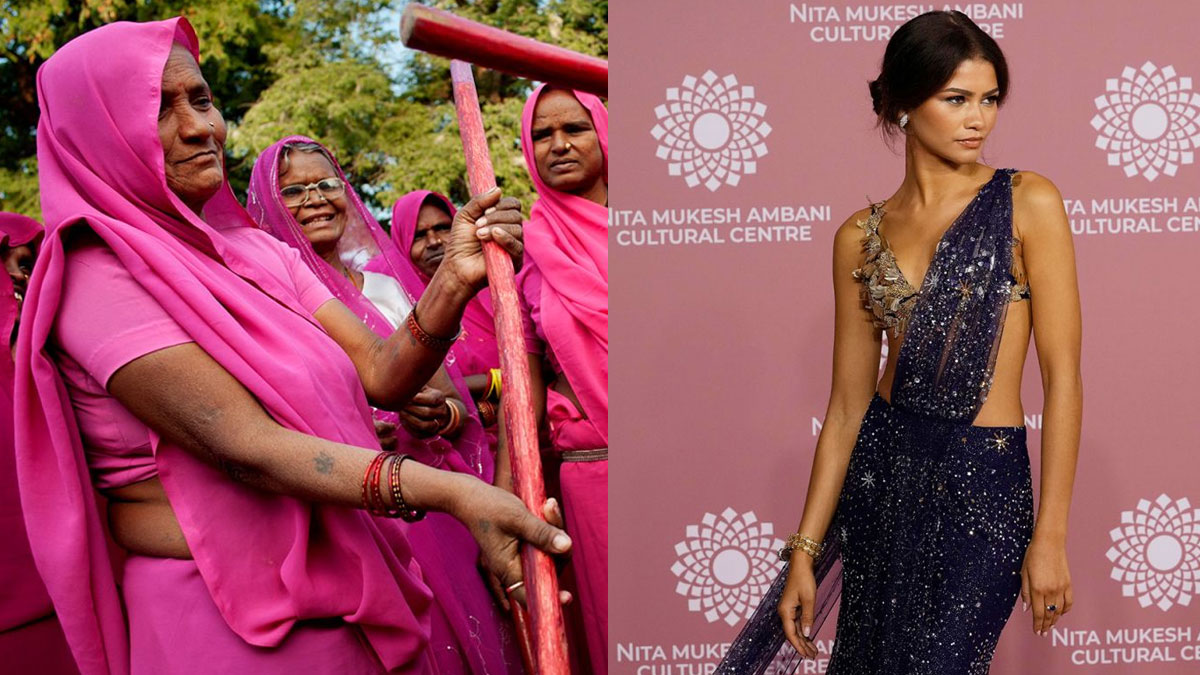
The ancient sari is having a moment in the Western world.
It began with actor Zendaya wearing a shimmering hand-embroidered blue sari gown and embellished bralette to a gala night at the Nita Mukesh Ambani Culture Centre in Mumbai in April.
The bespoke outfit — which took 3000 hours to make — was designed by Rahul Mishra, the first Indian couturier to show on the official schedule at Paris Haute Couture Week in 2020.
The piece inspired a blush and silver version shown at Mishra’s couture show in Paris last month.
At the 2022 Cannes Film Festival, Bollywood star Deepika Padukone made several best-dressed lists in a glittering black and gold sari from Indian designer Sabyasachi Mukherjee.
Then in May, the garment made appearances at the 2023 Met Gala — when model Naomi Campbell wore an archival pink sari-inspired dress by Chanel dating back to 2010 — and at Windsor Castle for celebrations marking King Charles III’s coronation, where businesswoman Natasha Poonawalla teamed a nude sheer sari with a Burberry body suit.
Now, the dress is being spotlighted further in a landmark show at London’s Design Museum. Running through September 17, “The Offbeat Sari” marks the first time an international museum has staged a show based solely on the historic drape.
Dating back to around 3,000 BC, saris traditionally consist of a single strip of unstitched cloth (conventionally between three and nine yards long), which can be draped — legend has it — in a hundred ways.
While the art of draping is traditionally passed down from mother to daughter, today there are plenty of “how-to” videos available online exploring less conventional takes and even simple pre-stitched versions available to buy which eliminate the need for draping altogether.
The garment remains one of the bestselling clothing items in India, widely worn both in rural communities and urban societies, though it’s typically donned for special events and during religious occasions.
Its uniform shape and generosity of size makes the sari the ultimate one-size-fits-all outfit — morphing to fit any wearer.
Often being made from cotton silk, saris are affordable, too — cotton silk saris usually retail across India for the equivalent of a few dollars. (Although then there’s the most expensive sari ever made, which cost 3,931,627 Indian Rupees — almost $100,000 — and weighed 18lb after it was hand-embellished for over 4670 hours with precious stones.)
Selected and arranged by the Design Museum’s head of curation, Priya Khanchandani, “The Offbeat Sari” presents over 60 garments, many on loan from weavers, artists and Indian designers including Mishra, Sabyasachi Mukherjee and Amit Aggarwal.
It aims to showcase how the sari exists as both a functional piece and as a symbol of female empowerment and activism, and examine recent experimentations with the style among emancipated South Asian women in the social media age.
These are people as diverse as the Gulabi Gang — a group of women in rural north India who took to wearing pink saris while protesting against domestic violence — to Gen Z figures such as Delhi-based Eshna Kutty, a dance artist who shares videos of herself hula-hooping in a sari, and actress and Instagram sensation Urfi Javed, whose customized styles push the boundaries of the sari and often polarize public opinion.
Giving an ancient garment new life
The Offbeat Sari exhibition also shines a light on the growing technicalities involved in the creation of the garment.
While woven materials such as silk, cotton or polyester are still popular and commonly used, newer designers such as Rimzim Dadu are pushing the boundaries of textiles, using ultra fine metal threads, for example, to repurpose heirloom saris.
This new take also brings modernity into the weaving traditions of India. “The sari is experiencing what is conceivably its most rapid reinvention in its 5000-year history,” said Khanchandani in the press release that accompanied the Design Museum show. “It makes the movement one of today’s most important global fashion stories, yet little is known of its true nature beyond South Asia.”
While saris have also been popular with celebrities — think Madonna at the VH1 Vogue fashion awards show in 1998, Lady Gaga in a Tarun Tahiliani white sari gown adorned with Swarovski crystals in 2011 (currently on display in the Design Museum’s show) and Dua Lipa while on vacation in Jaipur, India in 2018 — some instances have attracted criticism.
In a piece titled “The grey area between cultural appropriation and appreciation,” Vogue India called out Sarah Jessica Parker for her usage of the term “sari” during the 2022 Diwali episode of Sex and the City spin-off “And Just Like That.”
The garment she wore was not a sari at all but a lehenga (a three-piece outfit with a stitched skirt rather than a draped garment).
Similarly, Gwen Stefani sparked controversy for her penchant for wearing bindis and saris in the 1990s. In 2022, Stefani once again donned a sari to attend the 90th annual Christmas celebrations at the Rockefeller Center in New York — but on this occasion, the pre-stitched plisse number by Mumbai-based designer Amit Aggarwal was welcomed by much of the fashion community within India.
“It was extremely gratifying to see Stefani in our outfit,” Aggarwal told CNN during a telephone interview.
“It gave us an opportunity to showcase the work of our craftsmen and our innovative techniques with the form on such a large platform.”
Aggarwal believes the sari has already gone international. “It isn’t bound by borders or rules and has found love across the globe,” he said. “Its versatility and amorphous nature make it a piece of clothing to be worn in multiple ways simply by draping it differently.
(The sari) should no longer be ‘offbeat’ or something ‘exotic’ but mainstream. I think it’s beautiful to find people appreciating and embracing pieces of other cultures and blurring borders to make the world an even smaller place.”
Designer Rimzim Dadu agreed. “Experimentation is the basic need of humanity. Someone, somewhere thousands of years ago decided to experiment with five yards of fabric to see how it could be draped and the sari was born,” she told CNN via email. “It went through thousands of iterations over the years, so I would say both conservation and experimentation (with the sari) are extremely important as long as there is mutual respect for both.”
A history of inspiration
Dr. Phyllida Jay, anthropologist and author of the book “Inspired by India,” points out that internationally recognized designers from French couturier Madame Grès to Jean Paul Gaultier and Elie Saab have historically drawn inspiration from the garment. “My book tried to trace the ways the sari informed design innovation across the 20th century,” she said. While some did look at the sari as simply exotic or costume-like, Dr. Jay said designers who respect the garment and take time to understand the technical aspects of draping create the best international interpretations — take Cristobal Balenciaga’s sari gown, made famous by Elizabeth Taylor, or Gianfranco Ferré’s sari-inspired spiraling shirt dress.
In Mayfair, London’s luxury shopping district, the Indian multi-brand retailer Pernia’s Pop-Up Shop stocks the collections of around 50 Indian designers. Its owner, Abhishek Agarwal, told CNN that it’s not only the Indian diaspora purchasing saris from his store, but international shoppers too.
“Our vision has always been to make Indian fashion go international and provide a global platform for our country’s ground-breaking design industry,” he said. “The silhouette can easily transcend borders and cultures.”
Whether it is on the streets of Mumbai and Delhi, red carpets of New York, the galleries of London or the catwalks of Paris, admiration of the sari is only becoming more widespread.
“With India’s increasing political and economic power, its cultural prowess also will be accepted,” Delhi-based textile designer, Gaurav Jai Gupta told CNN in an email interview, adding: “I would love to see more people all over the world wear the sari.” Whether his wish will come true, only time will tell.
Source:CNN
Stay tuned for the latest news on our radio stations


